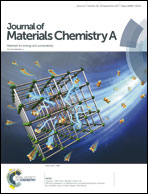Effect of sulfur-containing additives on the formation of a solid-electrolyte interphase evaluated by in situ AFM and ex situ characterizations†
Abstract
An effective solid-electrolyte interphase (SEI) layer is the key to the stable operation of lithium-ion batteries by minimizing the loss of lithium and decomposition of the electrolyte. Sulfur-containing additives can facilitate the formation of SEI layers and the effect of two sulfur-containing additives was investigated in this work. The growth of the SEI layer on a highly oriented pyrolytic graphite substrate during a cyclic voltammetry scan was monitored in situ using an atomic force microscope for imaging and an electrochemical workstation for controlling the potential of the electrode simultaneously. Both the ethylene sulfite (ES) additive and prop-1-ene-1,3-sultone (PES) additive can promote the formation of an SEI layer at higher potentials. The ES additive started to form an SEI at a higher voltage than the PES additive and the surface of the SEI layer appeared to be smoother. The effect of the additives was further evaluated in coin cells and the ES additive was found to enable superior stability of the cell in comparison to the PES additive and the neat electrolyte. Examination of the multi-cycled graphite electrode showed that the SEI layer formed with the ES additive was thicker and denser with low resistance for Li-ion conduction, which explains the high performance of the coin cell.



 Please wait while we load your content...
Please wait while we load your content...